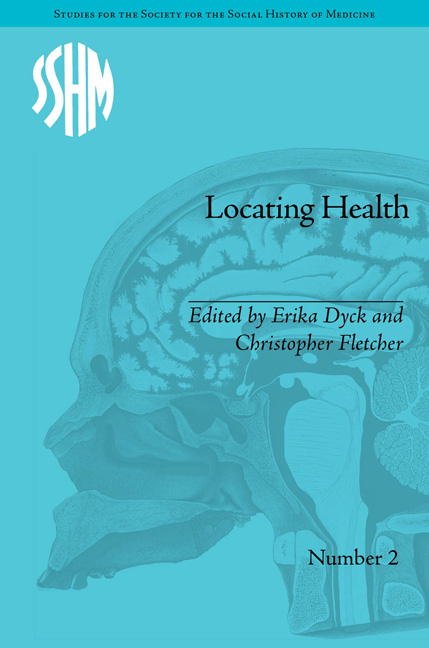Book contents
- Frontmatter
- CONTENTS
- List of Tables
- List of Contributors
- Acknowledgements and Preface
- Introduction: Healthscapes: Health and Place among and between Disciplines
- 1 Placing Maternal Health in India
- 2 Putting Medicine in its Place: The Importance of Historical Geography to the History of Health Care
- 3 Finding Place in The Big-Little World of Doc Pritham: Telling Medical Tales about Northwoods Maine, 1920s–70s
- 4 Putting Hyperactivity in its Place: Cold War Politics, the Brain Race and the Origins of Hyperactivity in the United States, 1957–68
- 5 Why Canada Has a Universal Medical Insurance Programme and the United States Does Not: Accounting for Historical Differences in American and Canadian Social Policies
- 6 Alberta Advantage: A Canadian Proving Ground for American Medical Research on Mustard Gas and Polio in the 1940s and 50s
- 7 Placing Illness in its Cultural Territory in Veracruz, Nicaragua
- 8 Chronic Disease in the Yukon River Basin, 1890–1960
- 9 An Ideal Home for the Consumptive: Place, Race and Tuberculosis in the Canadian West
- 10 Serbian Landscapes of Dreamtime and Healing: Clear Streams, Stones of Prophesy, St Sava's Ribs, and the Wooden City of Oz
- Notes
- Index
4 - Putting Hyperactivity in its Place: Cold War Politics, the Brain Race and the Origins of Hyperactivity in the United States, 1957–68
- Frontmatter
- CONTENTS
- List of Tables
- List of Contributors
- Acknowledgements and Preface
- Introduction: Healthscapes: Health and Place among and between Disciplines
- 1 Placing Maternal Health in India
- 2 Putting Medicine in its Place: The Importance of Historical Geography to the History of Health Care
- 3 Finding Place in The Big-Little World of Doc Pritham: Telling Medical Tales about Northwoods Maine, 1920s–70s
- 4 Putting Hyperactivity in its Place: Cold War Politics, the Brain Race and the Origins of Hyperactivity in the United States, 1957–68
- 5 Why Canada Has a Universal Medical Insurance Programme and the United States Does Not: Accounting for Historical Differences in American and Canadian Social Policies
- 6 Alberta Advantage: A Canadian Proving Ground for American Medical Research on Mustard Gas and Polio in the 1940s and 50s
- 7 Placing Illness in its Cultural Territory in Veracruz, Nicaragua
- 8 Chronic Disease in the Yukon River Basin, 1890–1960
- 9 An Ideal Home for the Consumptive: Place, Race and Tuberculosis in the Canadian West
- 10 Serbian Landscapes of Dreamtime and Healing: Clear Streams, Stones of Prophesy, St Sava's Ribs, and the Wooden City of Oz
- Notes
- Index
Summary
when the bears
hurled a spaceball
into heaven
from left field
us got real scared
us expanded our spaceball program us expanded our vocabulary too
us expanded everything
'till us then got the man in the moon
hah!
us beat them bears
yep!
us showed them bears
a giant leapfrog for all mankind
Introduction
In the late 1950s, the first American children were diagnosed with hyperactivity. They would not be the last. By 2006, the National Institute of Mental Health conservatively estimated that two million American children were afflicted with hyperactivity or Attention-Deficit/Hyperactivity Disorder (ADHD), a disorder characterized by hyperactive, inattentive, impulsive, defiant and aggressive behaviour. During the last five decades, these children have represented a major portion of the patients seen by American paediatricians, child psychiatrists and general practitioners, have been the subject of thousands of medical articles, textbooks and self-help manuals and have contributed significantly to the profits of pharmaceutical companies such as Novartis through sales of hyperactivity drugs such as Ritalin. Hyperactivity has also become a cultural phenomenon, identified with cartoon characters such as Dennis the Menace, Calvin (from the Calvin and Hobbes comic strip) and Bart Simpson, and a topic featured in television shows ranging from The Simpsons to The Sopranos.
The presiding opinion of most paediatricians, psychiatrists and other physicians that hyperactivity is merely a neurological condition fails to shed light on why educators, politicians and physicians during the late 1950s increasingly believed that hyperactive and distractible behaviour was pathological and warranted medical attention.
- Type
- Chapter
- Information
- Locating HealthHistorical and Anthropological Investigations of Place and Health, pp. 57 - 70Publisher: Pickering & ChattoFirst published in: 2014



